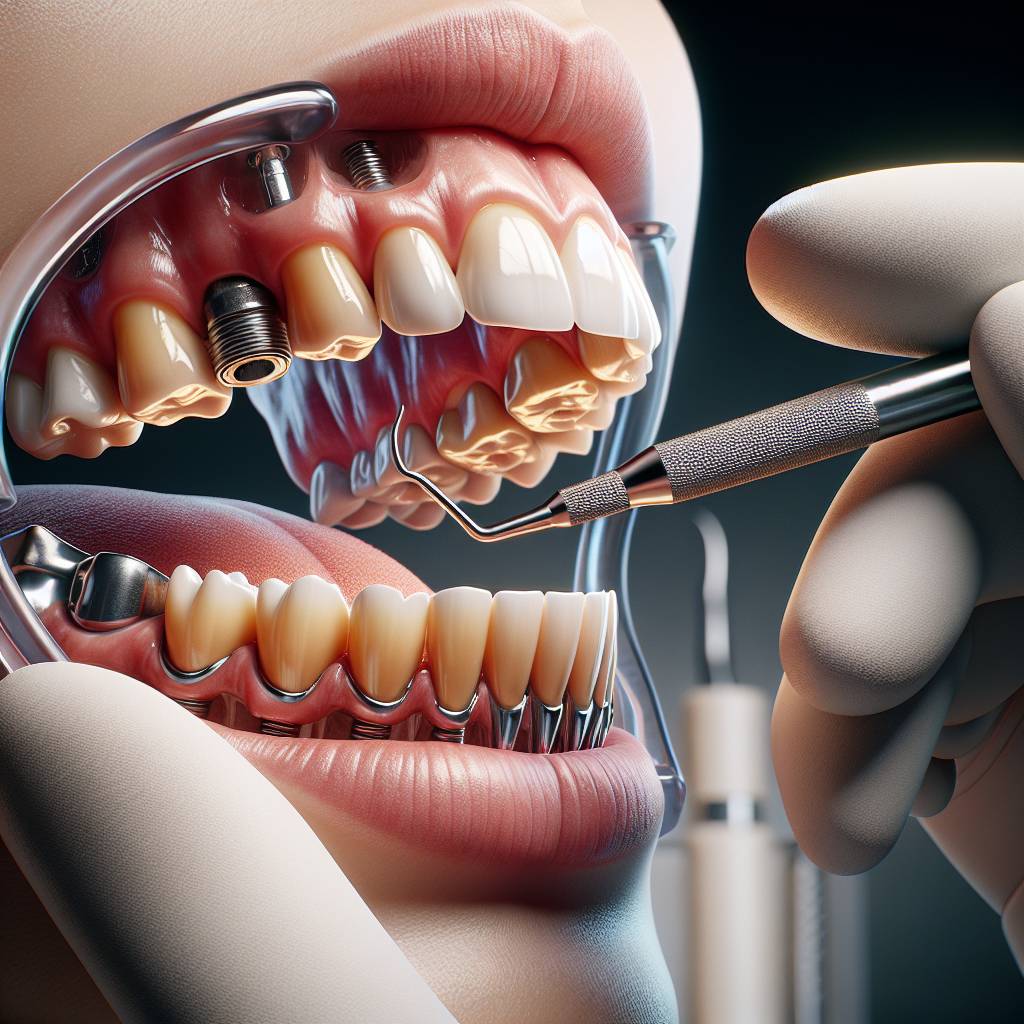Partial teeth are a type of prosthetic device that can help those who have lost multiple teeth in one or both jaws. It is an alternative to dentures, and it is also known as a bridge. Partial teeth consist of an artificial tooth, or multiple artificial teeth, held in place by a metal framework that is attached to the adjacent natural teeth. The metal framework helps keep the partial teeth in place and prevents them from shifting or slipping out of place. This article will discuss how partial teeth work and how they can benefit someone with multiple missing teeth.A partial tooth is a tooth that has been damaged either due to trauma or decay and is unable to be restored with a traditional filling. As a result, it needs to be partially removed and replaced with an artificial restoration such as a dental crown or bridge. Partial teeth can also be caused by grinding or clenching.
Types of Partial Teeth
Partial teeth are an effective way to replace multiple missing teeth. There are several types of partial teeth available to suit different needs. Removable partial dentures consist of false teeth attached to a gum-colored base that is held in place by metal clasps. This type of partial denture can be easily removed for cleaning and maintenance. Fixed partials, commonly known as bridges, are permanently attached to the adjacent natural teeth using metal bands or resin bonding. Crowns may also be used in certain cases to support the bridge. Implant-supported partials, or implant-retained dentures, use implants that are surgically placed into the jawbone and secured with abutments to hold the false teeth in place. These types of partial dentures provide a secure fit and natural feel compared to traditional partials.
No matter which type of partial tooth is chosen, it is important to maintain good oral hygiene habits for optimal results. Regular brushing and flossing will help keep the gums healthy and prevent plaque buildup on the false teeth. Regular checkups with a dentist can help ensure that any adjustments necessary for a comfortable fit can be made as soon as possible.
Benefits of Wearing Partial Teeth
Wearing partial teeth can be a beneficial solution for individuals with missing teeth. Partial dentures offer several advantages, including improved oral health, increased confidence, and better overall dental health. Partial dentures are a great way to replace multiple missing teeth without having to undergo a full set of dentures. They can also be used to fill in gaps in the smile that may have been caused by extraction or decay. When properly fitted and cared for, partial dentures can be a great solution for restoring an attractive smile and improving the overall health of the mouth.
One of the primary benefits of wearing partial teeth is improved oral health. When a tooth is missing, the surrounding gum tissue can deteriorate over time due to lack of support from the missing tooth root. This can lead to gum disease and other oral health issues such as halitosis (bad breath). By filling in gaps with partial dentures, individuals can prevent further deterioration and help maintain healthy gums and teeth.
In addition to improved oral health, wearing partial teeth also offers a boost in confidence for many people who feel self-conscious about their smiles due to missing teeth. Partial dentures allow individuals to replace multiple missing teeth quickly and easily, which helps them feel more confident when they smile or talk in social situations. A beautiful set of partial dentures will give individuals the opportunity to show off their smiles without feeling embarrassed about any gaps or noticeable spaces left by missing teeth.
Finally, wearing partial dentures helps promote better overall dental health. As with any type of tooth replacement option, it is important that they are properly fitted and cared for to ensure that they last as long as possible. Partial dentures should be cleaned regularly with special cleaning solutions designed specifically for this purpose, and should also be examined regularly by a dentist or dental hygienist to ensure that they are properly fitting and functioning correctly.
Overall, wearing partial teeth can have many benefits for those who are missing multiple teeth or have gaps in their smiles due to extraction or decay. Not only do they improve oral health by preventing further deterioration of gum tissue around the affected area, but they also provide an increase in confidence when smiling or talking in social situations. In addition, properly fitting and caring for a set of partial dentures will help promote better overall dental health.
How to Care for Partial Teeth
If you are missing some or all of your teeth, you may be considering getting a partial denture to restore your smile. Partial dentures are a great way to restore the look and function of your teeth. However, taking care of a partial denture is different than caring for natural teeth, and it’s important to know how to properly care for them. Here are some tips on how to care for partial teeth.
First, it’s important to brush and floss your remaining natural teeth every day. This will help keep them healthy and also help with the fit of the partial denture. You should also brush your partial denture every day with a soft-bristled toothbrush and non-abrasive toothpaste. Make sure that you brush all surfaces, including the area where the artificial teeth meet the gums.
It’s also important to soak your partial denture in a cleaning solution every night. This will help remove food particles and plaque that could build up on the surface of the dental appliance. You can use a commercial cleaner or an overnight soaking solution made from ½ cup of vinegar mixed with 2 cups of water.
Finally, it’s important to visit your dentist regularly for check-ups and cleanings. During these visits, your dentist will check the fit of your partial denture and make adjustments if necessary. They may also recommend using an adhesive product to keep the appliance in place while eating or speaking. With proper care and maintenance, you can ensure that your partial dentures stay in good condition for many years to come!
How to Clean Partial Teeth
Cleaning partial teeth can be a bit tricky, but it’s an important part of keeping your mouth healthy. Partial teeth, or bridges, are prosthetic devices that replace missing or damaged teeth. They are made out of metal and plastic, and they fit around your existing teeth to give you a complete smile. To keep them clean and in good condition, you need to brush and floss around them every day. Here are some tips on how to do this:
• Brush the partial teeth with a soft-bristled toothbrush. Use a circular motion, paying special attention to the areas where the partial meets the gum line. Make sure you get into all of the crevices and grooves where plaque can accumulate.
• Floss daily between the partial and your existing teeth. Use a flossing product designed for bridges or dental floss threaders that can help you get under the bridge more easily.
• Clean your partial in warm water at least once per day, using a soft toothbrush or cotton swab. This will help remove any plaque buildup and food particles that have accumulated on it throughout the day.
• Visit your dentist regularly for cleanings and checkups. Your dentist can check for signs of decay or damage to your partial or surrounding teeth and make sure everything is in good shape.
By following these steps, you can keep your partial teeth clean and healthy so they will last for many years to come!

Adjusting Partial Teeth
Partial teeth are a type of denture that can replace missing teeth. Adjusting partial teeth is an important part of maintaining good oral health and keeping the mouth comfortable. With proper care, partial teeth can last for many years. However, adjustments may be necessary due to changes in the shape of the mouth or to correct fit problems.
Visiting a dentist is the best way to adjust partial teeth. The dentist will examine the patient’s mouth and make any necessary adjustments. This may include trimming down the plastic material used in making the partial and creating a better fit between the artificial teeth and natural teeth.
If a patient experiences discomfort when wearing their partial, they should make an appointment with their dentist as soon as possible. It is important to address any fit problems right away so that further damage does not occur to either the natural or artificial teeth.
Patients should also be aware that there may be some adjustment period when wearing a new partial denture for the first time. It is not uncommon for patients to experience soreness in their gums and cheeks while adjusting to their new denture. If this persists or becomes uncomfortable, they should contact their dentist immediately for further adjustments or advice on how best to cope with this discomfort.
It is important for patients to take good care of their partial denture if they want it to last for many years without needing frequent adjustments. Care instructions should be followed carefully, including brushing with a soft-bristled toothbrush and soaking in mild denture solution overnight. Regular visits to the dentist will also help ensure that any fit issues are addressed before they become more serious problems.
The Costs of Wearing Partial Teeth
Partial dentures are a common solution for people who are missing some, but not all of their teeth. While they can be an effective way to restore the appearance of a full smile, there are some potential costs associated with wearing partial dentures. These costs can vary depending on the type of materials used, as well as the complexity of the dental work necessary to fit them properly.
The first cost associated with partial dentures is the cost of the materials used. Depending on what type of partial denture is being made, different materials may be used. For example, acrylic or flexible partial dentures will often use plastic or metal bases that are fitted with artificial teeth. These materials can be quite expensive and will need to be replaced periodically as they wear out over time. Additionally, more complex materials such as porcelain may also be used, which will further increase the cost of partial dentures.
The second cost associated with partial dentures is related to the dental work necessary to fit them correctly. This includes taking impressions and making sure that the partial fits properly in the mouth without causing discomfort or irritation to other areas of the mouth or gums. This can involve multiple visits to a dentist and may even require lab work to ensure that the partial fits correctly before it is worn for any length of time.
Finally, there are also ongoing costs associated with wearing partial dentures. These include regular cleanings and check-ups at a dentist’s office in order to ensure that the partials remain in good condition and are not causing any discomfort or irritation in other parts of the mouth or gums. Additionally, periodic adjustments may need to be made in order to maintain a proper fit for comfort and effectiveness.
In summary, there are many costs associated with wearing partial dentures that must be taken into account when considering this type of tooth replacement option. The materials used for constructing them can be costly, as well as any dental work necessary to fit them properly in the mouth. Additionally, ongoing costs such as regular cleanings and adjustments must also be taken into account when considering this option for replacing missing teeth.
Who Can Wear Partial Teeth?
Partial teeth are a great solution for people who have missing teeth. They can be used to replace one or more teeth, depending on the patient’s individual needs. Partial teeth are typically made from porcelain, ceramic, or acrylic and are fitted to the patient’s existing teeth to create a natural-looking smile. Partial teeth can be used by anyone who has missing teeth due to decay, trauma, or an inherited condition.
Patients with partial teeth require regular oral hygiene just like those with natural teeth. This includes brushing twice daily with a fluoride toothpaste and flossing at least once per day. It is also important for patients with partial teeth to visit their dentist regularly for check-ups and cleanings so that any potential problems can be identified early and addressed quickly.
Partial dentures are an ideal solution for those who want the appearance of a full set of healthy natural teeth but do not require the expense of bridges or implants. With proper care and regular maintenance, partial dentures can last many years, often even longer than traditional dentures. Partial dentures also look much more natural than traditional full sets of false teeth and can be customized to fit the patient’s unique facial structure and smile.
Overall, partial dentures provide an effective and affordable solution for anyone who is missing multiple or all of their natural adult teeth. They offer a comfortable fit that looks and feels like real teeth while also restoring your smile so you can enjoy all the activities you once did with confidence!

Conclusion
Partial teeth work by replacing lost or missing teeth with artificial, aesthetic replacements that are designed to match the patient’s existing teeth. The partial denture is securely attached to the existing teeth and gums and can be removed when necessary. Partial teeth provide a valuable solution when there are gaps in a person’s smile, helping them to feel more confident. They also help to prevent further damage from occurring due to the misalignment of remaining teeth and the deterioration of the jawbone caused by missing teeth.
Overall, partial teeth are an effective and reliable way of helping people restore a healthy and attractive smile. With correct maintenance and care, they can last for many years while providing a natural appearance that blends in with the rest of their smile.

